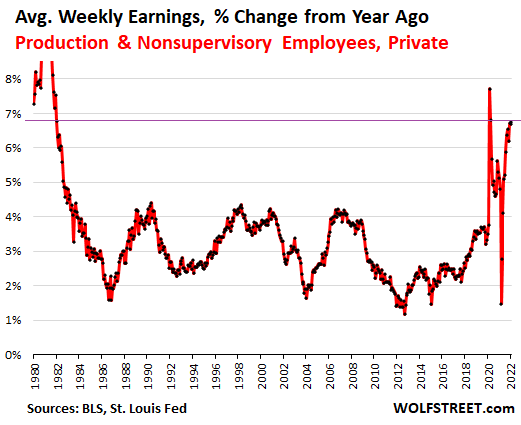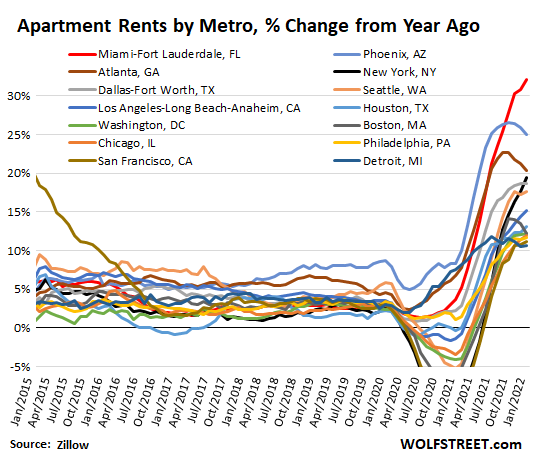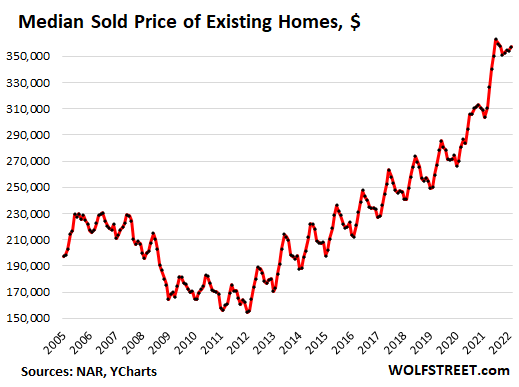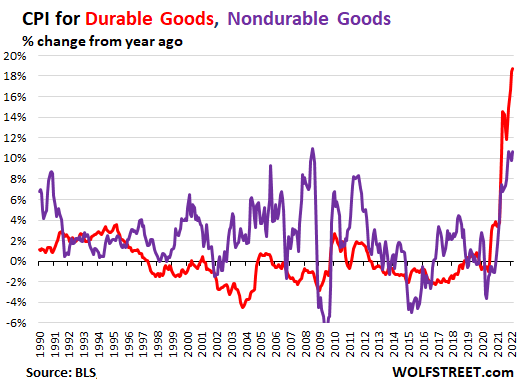How the Massive Gains in Average Hourly Wages Look Ludicrous Compared to the Reality of Spiking Prices
Rents, houses, used and new vehicles, gasoline, groceries, forget it, hahahaha
By Wolf Richter for WOLF STREET.
One of the results of the very tight labor market is the surge in hourly wages, particularly for workers in the category of private-sector “production and nonsupervisory employees,” where average hourly wages jumped by 6.7% for the third month in a row in March, compared to a year ago, according to the Bureau of Labor Statistics. Other than the lockdown distortions in April and May 2020, this was the biggest gain since early 1982.
These are workers in all industries and in all jobs that are non-management jobs, ranging from waiters to Facebook coders and Goldman Sachs traders. In dollar terms, the average wage of Production and Nonsupervisory Employees increased by $0.11 from the prior month, and by $1.71 from a year ago, to $27.06.

The distortions in average wages that occurred in April and May 2020 reflect the effects of the lockdowns, when many lower-wage employers, such as restaurants and retailers, were shut down, and their employees were laid off. Their relatively lower wages fell out of the averages, while many people in higher-paying service jobs, such as those in financial services, tech, and other sectors, switched to working from home.
As millions of lower-wage people were laid off, the higher wage earners became a bigger proportion of the earners and pushed up the year-over-year gains in average hourly wages. In April and May 2021, the low year-over-year gains reflect the high base a year earlier.
Average hourly earnings in the private sector overall increased year-over-year by 5.6% in March. In dollar terms, the average increased by $1.67 year-over-year, to $31.73 per hour.
But these big wage gains were out-spiked by prices.
Despite the biggest increases in average hourly wages for production and nonsupervisory workers since 1982, these folks are worse off. They might feel better about their higher wage for a little while, until they try to buy something – and discover that prices have out-spiked those wages gains by a wide margin:
Rents of apartments and single-family houses across the US, according to Zillow’s Observed Rent Index, spiked by 17% from a year ago, two-and-a-half times the pace of the wage gains.
Rents spiked by 11% or more in all of the largest 14 metros, at the top: Miami (+32%, red line), Phoenix (+25%, blue line), and Atlanta (+20%, brown line). The smallest spike of the largest 14 metros was in Detroit (+11%).

The median home price across the US jumped by 15% from a year ago, to $357,300, according to the National Association of Realtors. This was more than double the pace of the wage gains:

Prices of durables goods – dominated by new and used vehicles, but also furniture, consumer electronics, etc. – spiked by 18.7% in February, according to the Consumer Price Index for durable goods, by far the worst price increases in the history of the monthly CPI data going back to the 1950s (red line in the chart below).
This spike was over two-and-a-half times the pace of the wage gains. It was fueled by prices of used vehicles (+41.2% = 6x wage gains) and new vehicles (+12.4% = nearly 2x wage gains).
Prices of nondurable goods – dominated by food, gasoline, other energy, and household supplies – spiked by 10.7%, the worst price increases since July 2008 (purple line):

This is why inflation is an insidious force.
The biggest gains in compensation occur at the top, executives of major companies are getting raises that amount to millions of dollars, in addition to massive stock compensation packages. And many highly-paid employees at these companies are getting massive compensation increases in dollar terms, along with their stock compensation plans. Their stockholdings have ballooned since March 2020 in line with the Fed’s money-printing orgy. Those folks might grumble about higher costs, and shake their heads at the gas pump, but they will be fine in this crazy inflationary environment.
But the people that earn hourly wages, they will not be fine. Their raises might make them feel better briefly – until they have to go fill up their car, buy groceries, pay for the rent increase, or buy a car. And if they want to buy a house, well, forget it. In addition to home prices having run away from them, mortgage rates have now jumped. And those 6.7% in wage increases are going to look ludicrous compared to reality.
Enjoy reading WOLF STREET and want to support it? Using ad blockers – I totally get why – but want to support the site? You can donate. I appreciate it immensely. Click on the beer and iced-tea mug to find out how:

Would you like to be notified via email when WOLF STREET publishes a new article? Sign up here.
![]()
[ad_2]
Source link


